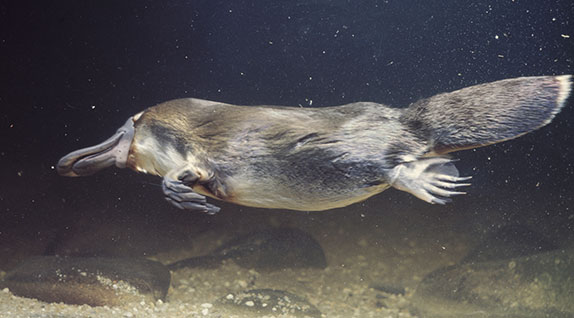 Thinkstock
Thinkstock
Article
First believed to be a hoax, then touted as evidence of evolution, the story of the duck-billed platypus is full of twists and turns.
Learn the why behind the headlines.
Subscribe to the Real Truth for FREE news and analysis.
Subscribe NowIt has happened! Evolutionary scientists rejoice!
A creature has been discovered that connects all the pieces and is truly the “missing link.” While similar stories have ended in disappointment many times before, this is finally the one!
No longer will these experts be peppered with constant questions: Why are there so many gaps in the fossil record? Why do we not see transitional animals today? When did birds, reptiles and mammals evolve from a common ancestor? How exactly did it happen?
Day after day, evolutionists are faced with seemingly insurmountable hurdles. But this ground-breaking discovery has solved their woes.
This time the discovery is not just a bone fragment, or partial fossil—as is often the case—it is a living, breathing creature. It has the features of a reptile, bird and mammal—all in one small, furry package.
The search for proof is over!
This likely was the thinking of evolutionists when they first applied the theory to the duck-billed platypus.
But the mammal’s story began much earlier in 1798, when an artist’s sketch and pelt were sent from Australia to Great Britain describing an exceptional new find. The description was so extraordinary that, when the specimen reached Britain, it was immediately dismissed as a fraud.
One scientist actually used scissors to attempt to locate the stitches attaching the supposed duck’s bill to the furry mammalian body.
Much to the embarrassment of the scientists, this remarkable creature was determined to be real. In time, it became a darling of evolutionists.
Yet, as the creature was studied, researchers found it possessed some surprising attributes. With the passing of time, they were continually baffled by this mammal—as are scientists today.
Truly Unique
The platypus looks like no other creature on Earth. Physically, it appears to be a hybrid blend of a bird, beaver, reptile and otter, with additional characteristics not contained in any of these four!
On cursory examination, the platypus has a bill that most resembles that of a waterfowl, not the mouth of any known mammal. Yet it is not an ordinary bill. It is actually a well-designed sensory organ. Not a nose, but a highly sensitive electrolocation sensor, detecting miniscule electrical impulses generated by its food source of small crustaceans and worms. No other mammal has a sensor so highly developed—in fact, only one other mammal has this ability at all.
Then there are the webbed feet, similar to those found on otters. Unlike an otter, however, the webbing is far more pronounced on the front feet of the platypus, which it uses like paddles for swimming. While in the water, the back feet are tucked into its body and hardly used at all.
Another pronounced platypus attribute is its beaver-like tail. As with its other features, upon closer inspection, there are as many differences as similarities. A beaver’s tail is covered in scales, is flattened, and propels the rodent through the water when swimming. On the other hand, the tail of the platypus is covered in fur and is used more in the way a rudder might guide a boat. Once again, initial appearances are deceiving.
Additionally, this remarkable creature does something almost unheard of in the mammalian class. It lays eggs! On first inspection the eggs appear reptilian, but internally are structured more like those of a bird. However, unlike the process in both birds and reptiles, platypus embryos spend a much longer time in the mother. For instance, chickens lay eggs roughly 24 hours after fertilization, while a platypus waits 28 days. Their eggs spend nearly twice as long developing inside the female’s body as outside.
If you were pitted against a platypus in a street fight, you would want to avoid two sharp heel spurs found behind its hind feet. Not only could these spurs pierce your skin, but they could also inject a nasty surprise.
Male platypuses carry a toxin strong enough to kill a dog and incapacitate an adult man. When inflicted, the wound rapidly swells with fluid and becomes extremely painful. The victim experiences a heightened sense of pain that can last for days—or even months. The platypus is one of few mammals with venom strong enough to affect a human. The particular toxin contains three proteins unique to the platypus.
Characteristics that initially made evolutionists excited about the platypus are vastly different from what was expected and seemingly unconnected that scientists are left perplexed to this day.
Evolutionary Quandary
The platypus poses some interesting problems for evolutionary scientists. Here is a creature that appears to be right in the middle of a supposed evolutionary transition, yet fossils dated to millions of years ago look almost identical to the modern animal.
If the platypus is a transitional specimen, why did it seemingly stop evolving? Why has it remained virtually unchanged for its entire existence?
Even the minor changes are disappointing to scientists, as they could more aptly be considered de-evolution. For instance, the fossilized adult platypus had functioning teeth. Yet modern platypuses lose their teeth at an early age, leaving only a horned plate with which to grind and mash their food to a pulp, prior to swallowing.
Hardly advancement at all!
Further, consider the watery environment in which a platypus survives—in fact, thrives. (When a platypus is removed from its natural habitat, its lifespan is greatly abbreviated.)
As with many other mammals, it has eyes, ears and a nose. All three are fully functioning and would serve a platypus well if it spent much time on land. On the other hand, its heavily webbed front feet force it to walk on its knuckles, or risk damaging the somewhat fragile webbing. In the water, the beauty of the animal’s design becomes apparent. It maneuvers gracefully with speed and precision while foraging for food.
Though it spends the majority of its time in water, the platypus never evolved an ability to hold its breath for very long, typically no more than 30 seconds. How is it that an animal living primarily in the water for “millions” of years still cannot hold its breath for more than half a minute?
Imagine the hypothetical evolutionary path of this extraordinary creature. Suppose there was a time before all of the animal’s features were fully formed. (The fossil record demonstrates no such instance.) These early platypuses would have had no webbed feet or electrolocation system. Instead of gliding skillfully through the water, this poor animal would have flailed about, with no method to navigate or find food. (Yet, somehow, over millions of years, it would have managed to survive drowning, starvation and predators.)
Over time, the platypus would have “decided” that webbed feet were needed, and evolved a version unlike that of any other creature. Then, instead of its eyes, nose and ears adapting to work underwater, it evolved a device that looks like a duck’s bill, but instead is the most advanced electrolocation system found on any mammal.
Given this unlikely scenario, this must have happened another way. The fossil record indicates that the platypus appeared fully formed, with all of its “adaptations” perfectly balanced.
There is only one explanation for how so many separate, seemingly disparate, component parts of the platypus could come together in a final product that functions so well. It would take a plan before the platypus existed, millennia ago.
The same Creator who is responsible for the complexity of the entire universe—and all life therein—also created this marvelous animal.
The thinking person, however, wants proof of a Creator—and understandably so. Often, it is at this point that evolutionists think they have the upper hand. They claim to hold to reason, logic and “just the facts.” When pushed, most people who believe in God will say they can offer no proof, and simply “have faith” that He exists.
The platypus, on its own, does not prove the existence of an all-powerful God, but it adds more evidence to the case. Once compiled and carefully considered, it leads to the only obvious conclusion.
Think. If God created the entire universe, placed mankind on Earth, and then expected all to obey Him—would He not also offer absolute proof that He exists? The duck-billed platypus does not need to be a mystery, nor does the existence of the God who created it. You can know for certain!
Evolutionists and atheists often claim science proves God does not exist, but this is not true! Rock solid evidence for God’s existence is found among the varied fields of biology, astronomy, chemistry and mathematics. Watch Does God Exist?—Many Absolute Proofs! (Part 1) to learn more!



